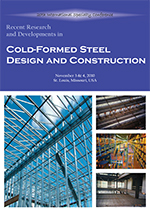Session Dates
03 Nov 2010
Abstract
Roof deck construction often incorporates cold-formed steel panels that are connected to the underlying framing with the use of arc-spot welds. The welds are commonly located in areas where multiple layers of roof deck exist, such as at sidelaps or endlaps. CSA S136 restricts the use of multi-layer connections to being less than 2.5 mm thick; as well, the thickness of the supporting steel must exceed 2.5 times the aggregate thickness of the deck. In effect, the standard does not allow for the use of arc-spot welds for 18 ga (1.21 mm) and 16 ga (1.52 mm) roof deck panels. Nonetheless, it is not unusual for these deck panels to be used in construction; a solution to the arc-spot weld restrictions and a new welding protocol was needed. This situation led to the initiation of a research program on the shear resistance and tension resistance of multi-layer arc spot welds. The paper describes the welding protocol that was developed to obtain adequate quality and size arc-spot welds in up to four layers of 16 ga. deck. Weld test specimens were fabricated through one, two or four layers of steel sheets with thicknesses ranging from 22 ga. (0.76 mm) to 16 ga. (1.52 mm). Various sheet steel / weld configurations found in roof deck construction were included. A total of 72 tension tests and 107 shear tests were completed. Adequate weld quality could be achieved in all cases except that welds were undersized when the total sheet thickness becomes twice as large as the thickness of the underlying material. The results were compared with the current provisions of CSA S136 and modifications to the existing design equations are recommended.
Department(s)
Civil, Architectural and Environmental Engineering
Research Center/Lab(s)
Wei-Wen Yu Center for Cold-Formed Steel Structures
Meeting Name
20th International Specialty Conference on Cold-Formed Steel Structures
Publisher
Missouri University of Science and Technology
Document Version
Final Version
Rights
© 2010 Missouri University of Science and Technology, All rights reserved.
Document Type
Article - Conference proceedings
File Type
text
Language
English
Recommended Citation
Guenfoud, N.; Tremblay, R.; and Rogers, C. A., "Arc-spot Welds for Multi-overlap Roof Deck Panels" (2010). CCFSS Proceedings of International Specialty Conference on Cold-Formed Steel Structures (1971 - 2018). 2.
https://scholarsmine.mst.edu/isccss/20iccfss/20iccfss-session11/2
Arc-spot Welds for Multi-overlap Roof Deck Panels
Roof deck construction often incorporates cold-formed steel panels that are connected to the underlying framing with the use of arc-spot welds. The welds are commonly located in areas where multiple layers of roof deck exist, such as at sidelaps or endlaps. CSA S136 restricts the use of multi-layer connections to being less than 2.5 mm thick; as well, the thickness of the supporting steel must exceed 2.5 times the aggregate thickness of the deck. In effect, the standard does not allow for the use of arc-spot welds for 18 ga (1.21 mm) and 16 ga (1.52 mm) roof deck panels. Nonetheless, it is not unusual for these deck panels to be used in construction; a solution to the arc-spot weld restrictions and a new welding protocol was needed. This situation led to the initiation of a research program on the shear resistance and tension resistance of multi-layer arc spot welds. The paper describes the welding protocol that was developed to obtain adequate quality and size arc-spot welds in up to four layers of 16 ga. deck. Weld test specimens were fabricated through one, two or four layers of steel sheets with thicknesses ranging from 22 ga. (0.76 mm) to 16 ga. (1.52 mm). Various sheet steel / weld configurations found in roof deck construction were included. A total of 72 tension tests and 107 shear tests were completed. Adequate weld quality could be achieved in all cases except that welds were undersized when the total sheet thickness becomes twice as large as the thickness of the underlying material. The results were compared with the current provisions of CSA S136 and modifications to the existing design equations are recommended.



